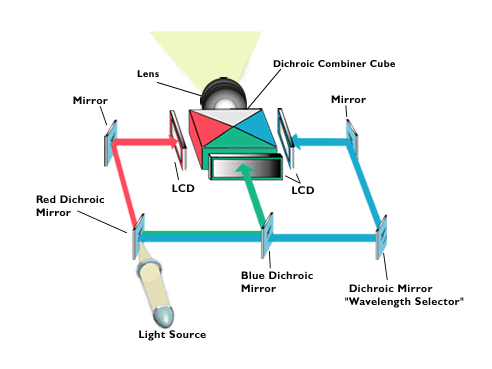Decoding the World of Projectors: A Comprehensive Guide to Understanding Their Functionality
Introduction
Understanding projectors and their functionalities can be complex due to the wide variety of types and uses. This comprehensive guide helps decode the world of projectors, navigating through its types, core functions, essential uses, and things to consider when choosing the right one. Whether you're deciding which projector to use for your business presentations, your classroom, or your home theater, this guide is here to help you make an informed decision.
What Exactly is a Projector?
So, what is a projector? Let's delve deep. A projector is a sophisticated output device, with the primary purpose of enlarging images from a variety of sources and effectively projecting them onto a screen, a wall, or any other given surface. This operation may sound simple, but the method used for this process varies across different types of projectors. Here are a few key elements that define a projector:
- Light Source: The core functionality of a projector is largely based on its light source. Essentially, it works by emanating light through a tiny, transparent lens. The manipulation of this light projection forms the basis of the image creation process.
- Image Generation: A projector can take images produced by various devices like a computer or a video player. This is possible because projectors are designed to interpret signals sent by these devices and convert them into larger, viewable images.
- Image Enlargement: The major hallmark of a projector is its ability to magnify an image. This ensures the projection is cl
early visible on a much larger display, thereby facilitating collaborative viewing in larger settings. From business presentations to classroom instruction or home cinema experiences, this managed enlargement is pivotal.
In a nutshell, a projector should not just be seen as a mechanism that projects images. Its potential lies in its capability to convert small, hard-to-view images into larger pictures, bridging the gap between individual viewing and shared experiences.
Different Types of Projectors: Which One is For You?
There is a diverse range of projectors out there, each with its unique features and applications. Understanding each category can guide you in choosing the one that perfectly aligns with your requirements.
- Multimedia Projectors: Multifaceted in nature, these projectors are widely used in classrooms and business meetings due to their ability to handle motion and 3D graphics, video display and high-resolution data.
- Pocket Projectors: Compact and portable, these projectors are ideal for on-the-go presentations or impromptu movie nights. Although they may not offer the high resolution of larger models, their convenience factor is unbeatable.
- Fixed Installation Projectors: With a focus on offering superior image quality and brightness, fixed installation projectors are perfect for large venues such as auditoriums or concert halls.
- Home Theater Projectors: If you're passionate about upscaling your home viewing experience with cinema-quality visuals, these high-definition projectors are your best bet. They prioritize vivid color balance, contrast, and high resolutions, making them perfect for movie or gaming enthusiasts.
Discovering the best projector type will essentially depend on your intended use - whether it's bringing presentations to life, enjoying immersive movie sessions at home, facilitating large-scale viewings, or simply projecting on the move. There is a projector tailored to meet all of these requirements, once you equip yourself with the knowledge to make an informed choice. Remember, the key is in understanding your unique needs and matching them with the right type of projector.
Understanding the Core Functions of a Projector: What Makes it Tick?
A projector, while seemingly simple, functions based on several core principles and components. It primarily involves magnifying an image and displaying it onto a larger surface like a screen or a wall. Here's a look at the key aspects that drive a projector's functionality:
1. Image Interpretation: The projector acts as an interpreter. It translates the signals sent by various input devices such as a computer, a TV set, or Blu-ray device into images that are viewed by the audience.
2. Brightness Factor: The brightness of a projector, measured in lumens, is a critical aspect of its functioning. Higher lumens mean more brightness, and therefore, better visibility, especially in well-lit rooms.
3. Contrast Ratio: This is another attribute that determines the quality of the displayed images. The contrast ratio in projectors describes the differential between the whitest white and the darkest black. A higher contrast ratio depicts deeper black levels and thus presents a more realistic and vivid image.

4. Resolution: Resolution is a measurement of the display's detailed ability. Higher resolution projectors offer clearer and more detailed images. It is usually recommended to match the projector's resolution with the resolution of the input device for the best viewing experience.
5. Color: The color quality, including aspects like saturation, accuracy, and balance, significantly impacts the overall image quality.
6. Connectivity Options: A projector's compatibility with various devices often depends on its connectivity options. Most projectors come with multiple connectivity ports such as VGA, HDMI, and more recently, Wi-Fi capabilities for wireless connections. These options allow a broad spectrum of multimedia presentations.
In essence, understanding the core functionalities of a projector enables users to tap into its full potential. Armed with this knowledge, one can make more informed decisions when choosing a projector that caters to specific needs, be it for a business presentation or a movie night at home.
Why Are Projectors So Essential in Various Fields?
The key facet of projectors, enhancing visibility through large-scale image display, caters to various needs across diverse fields. Here's an in-depth look at how projectors contribute indispensably to these sectors:
1. Education: In academic settings, projectors are a boon. They facilitate collaborative learning, bringing students and teachers together through interactive presentations or digital class activities. What’s more, 65% of people are visual learners, which speaks to the importance of this tool in educational institutions.
2. Business: Within the corporate world, projectors play a substantial role in helping articulate complex ideas during team meetings, seminars, or conferences. An integral part of the boardroom, projectors make it easy for businesses to showcase data-driven presentations, boosting clarity and comprehension.
3. Entertainment: For home theater enthusiasts, projectors create a cinematic experience right at home. They allow for larger-than-life visuals, turning your living room into an immersive film-viewing space.
4. Art and Design: For those in the creative field, projectors can be used to present artworks, designs, or concepts to clients or collaborators. They offer the liberty to demonstrate various color palettes, textures, and designs on a broader scale.
From a statistical perspective, the global projector market size was valued at USD 2.54 billion in 2018 and is expected to grow at a compound annual growth rate (CAGR) of 8.8% from 2019 to 2025. This statistic substantiates the growing importance of projectors in various fields.
However, while projectors indeed provide a range of benefits, it's essential to choose the right one based on your specific needs. For instance, a business may prioritize a projector with superior resolution and connectivity options, while home theater enthusiasts might opt for projectors offering superior contrast ratios and color accuracy. Essentially, projectors are transforming how content is consumed and created, making them a vital tool in education, business, and entertainment sectors.
Selecting the Right Projector: What Should You Look For?
Once you enter the domain of projectors, it can be daunting to choose the one that fulfills your requirements perfectly. Various factors weigh in when deciding to invest in a projector. Let's break down what you should consider:
1. Functionality: What is your primary need for the projector? Home theatre, business presentations, or educational purposes? Your requirements dictate the type of projector you should lean towards.
2. Brightness: The projector's brightness measured in lumens directly affects the visibility of your presentations. A higher lumen count works well in well-lit rooms while a lower lumen count is sufficient for darker rooms.

3. Contrast Ratio: An essential factor in image quality. A higher contrast ratio means deeper blacks and more vibrant colors.
4. Resolution: The clarity of the image is dependent on the resolution. Higher resolution offers more detailed visuals, which is crucial for HD movies or detailed presentations.
5. Color Accuracy: This determines how true to life the projected colors are. Important for photography, videos, and design presentations.
6. Connectivity: What are your source devices? Make sure the projector has the necessary ports and connectivity options, like HDMI, VGA, USB, and wireless connectivity.
These essential components, when considered, can help successfully determine the ideal projector to cater to your needs, ensuring a worthwhile investment.
Conclusion
Projectors are becoming increasingly useful in various fields such as business, education, and entertainment because they allow content to be shared with large audiences. They provide an impactful way of communicating ideas or entertaining a crowd with visuals.
Related FAQs about what is projector and its function
How have projectors evolved over time?
Projectors have remarkably evolved over the years. Initial models like the Opaque Projector were large and cumbersome. Then came overhead and slide projectors, followed by the digital revolution with LCD and DLP projectors. Nowadays, projectors are compact, offer high resolution, wireless connectivity, 3D imagery, and wide color ranges.
Can the same projector be used in different settings like schools, homes, and businesses?
While it's possible to use the same projector in different settings, it's not always ideal. Each setting has unique requirements. For instance, a business projector might prioritize resolution and connectivity, a classroom projector may need interactive capabilities, while a home theater projector might focus on high contrast and color accuracy.
What differentiates a standard projector from an interactive one?
A standard projector purely displays images or videos on a screen. An interactive projector, on the other hand, allows users to interact with the displayed content using a pointer or fingers. It's like having an interactive whiteboard, enhancing collaborative efforts in classrooms or business settings.


